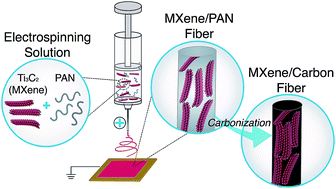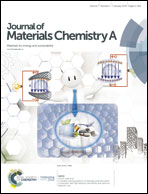Electrospun MXene/carbon nanofibers as supercapacitor electrodes†
Abstract
Free-standing Ti3C2Tx MXene/carbon nanofiber electrodes are prepared via electrospinning Ti3C2Tx MXene flakes with polyacrylonitrile (PAN) and carbonizing the fiber networks. Using this simple fabrication method, delaminated MXene flakes are embedded within carbon nanofibers and these fiber mats are used as electrodes without binders or additives. Unlike coated electrodes, which may suffer from the active material delaminating from the substrate during folding or bending, composite electrodes are stable and durable. Previous attempts to incorporate Ti3C2Tx MXene into electrospun fibers resulted in low mass loadings, ∼1 wt% Ti3C2Tx MXene. In this work, MXene flakes are added into PAN solutions at a weight ratio of 2 : 1 (MXene : PAN) in the spinning dope, producing fiber mats with up to 35 wt% MXene. Composite electrodes have high areal capacitance, up to 205 mF cm−2 at 50 mV s−1, almost three times that of pure carbonized PAN nanofibers (70 mF cm−2 at 50 mV s−1). Compared with electrospun nanofibers spray-coated with Ti3C2Tx, these composite fibers exhibit double the areal capacitance at 10 mV s−1. This method can be used to produce MXene composite fibers using a variety of polymers, which have potential applications beyond energy storage, including filtration, adsorption, and electrocatalysis, where fibers with high aspect ratio, accessible surface, and porosity are desirable.

- This article is part of the themed collection: 2019 Journal of Materials Chemistry A Most Popular Articles


 Please wait while we load your content...
Please wait while we load your content...